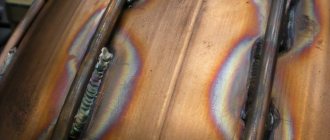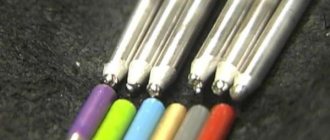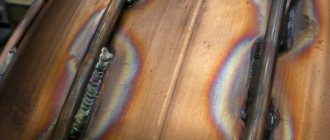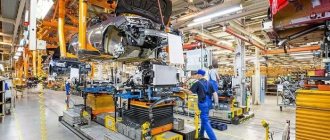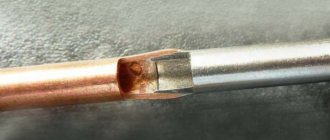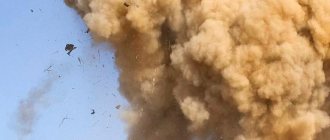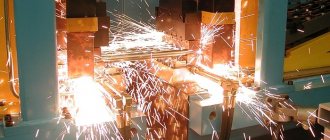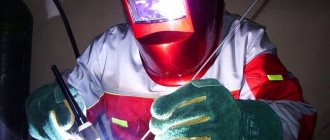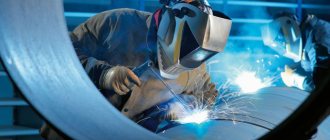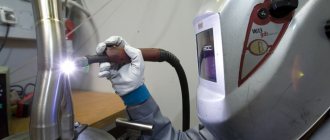Often there is a need to connect parts, for example, made of aluminum, copper, titanium, etc. In such cases, argon arc welding is used, which is a hybrid of electric arc and gas. Before cooking with argon, you need to learn how to maintain the distance between the part and the electrode and how to operate the burner correctly.
Argon welding is very popular.
Definition of argon welding
In this type of welding, an electric arc burns in an environment of inert gas argon, which protects the surfaces being welded from exposure to oxygen.
Sometimes argon is replaced with helium: it has similar properties, but is more expensive, so it is used less often. The principle of operation in helium and argon environments is the same.
Application area
This type of welding is widely used not only in various industries in arc, plasma or laser welding. Home craftsmen actively use it in everyday life to join high-alloy alloys and rare earth metals. Gas welding is quite dangerous, and it is not worth storing such equipment in the garage, but this does not apply to argon, because. it is completely safe and does not explode.
There are steel cylinders with this gas with a capacity of 15 to 40 liters on sale. If you need to cook infrequently, you can purchase a small tank that will last a long time. Since no harmful toxins are released when working with such equipment, it is not dangerous for strangers to be near it.
General principle of technology
Inert gas protects the welding site from the negative effects of oxygen. Due to the potential difference between the electrode and the workpiece, an electric arc appears and a high temperature is created. The edges of the parts begin to melt, resulting in the formation of a weld pool. An additive is constantly supplied to this zone, as well as argon under pressure: it protects the materials being welded from oxidation.
The welding principle is based on joining metal surfaces in a protective gas environment.
To understand how to cook with argon correctly, you need to understand the structure of the main working element of the equipment. This is a burner in which a tungsten non-consumable electrode and a nozzle through which argon is supplied are fixed. When the thickness of the workpieces being joined is small, welding can be performed without the use of filler material.
Connection to the electrical network is carried out in 2 ways:
- straight polarity (minus is applied to the workpiece, and plus is applied to the working rod);
- reverse (here everything is the other way around, but this leads to unstable arc burning and premature wear of tungsten).
Most often they work with direct current, and when welding aluminum and beryllium they use alternating current.
Properties of gas and effect on metal
Due to its physical and chemical characteristics, argon does not enter into chemical compounds with other substances: even at high temperatures it does not interact with oxygen. It can be used when welding various metals and alloys in industrial and domestic conditions. Inert argon almost completely isolates the molten material in the weld pool from oxygen in the air, so the seam does not oxidize .
Basic properties of argon:
- almost 40% heavier than the components that make up the air, so it easily displaces them from the welding area;
- does not take part in the direct welding of metals and does not affect their structure in any way;
- when reverse polarity is used, it acts as an electrically conductive medium.
Features of using the inverter
When performing argon arc welding in industrial and domestic conditions, an inverter is used. This equipment is used to convert alternating current into direct current. Domestic power grids often experience voltage surges, but modern inverters are well adapted to this and provide stable output values.
When performing argon arc welding, inverters are used.
The devices used in this type of welding are distinguished by their low weight and dimensions, high reliability and ease of maintenance. All this allows novice welders to easily master the equipment used and the argon welding process itself.
Inverter welding of stainless steel in an argon environment, compared to other methods of joining such alloys, is simple. Here the welder only needs to move the torch correctly along the seam.
If the edges of the workpieces are tightly connected, then the work can be done without the use of filler wire.
What is the principle of argon welding based on?
Argon welding is a hybrid technology - thanks to it, it is possible to join metals that are considered the most difficult to work with. The principle of argon welding works great with both large pipes and tiny bronze figurines. The fact is that this method combines the best of two classical methods: electric arc and gas. The most common example of working with argon is welding stainless steel.
Before discussing the operating principle of argon welding, it is necessary to understand the physics of this process. It is no secret that joining metal surfaces is impossible without heating them. But since heating requires the use of fire, the oxygen contained in the air is also involved, which triggers the oxidation reaction. The problem is that complex metals or alloys such as alloy steels or non-ferrous metals are highly susceptible to oxidation.
Oxidation is dangerous because it significantly reduces the quality of the seams - they become fragile and quickly deteriorate. This occurs due to the formation of many tiny bubbles in the seam. If we talk about aluminum, it begins to burn when heated under normal conditions.
The principle of argon welding is used primarily to protect the welding pool from gases and impurities. Inert gases act as a protective shell; this can be not only argon, but also helium. However, a serious disadvantage of the latter is its high price and high consumption. For example, when processing stainless steel, several times more helium is required than argon. Another feature of using helium is that you cannot work with it without protective clothing that completely covers the body.
VT-metall offers services:
Due to what we described above, helium today is rarely used in its pure form; it is used in mixtures for gas lasers. Another inert gas is nitrogen. It is exclusively suitable for working with copper. Therefore, the main and most common inert component used in the hybrid approach is argon.
Let's name the main qualities of argon:
- Much heavier than air . It is thanks to this that it easily occupies the entire weld pool, protecting the melting zone from other gases.
- It is inert , therefore it does not react with other elements, but, most importantly, it does not interact in any way with the surfaces being welded - this is the principle of argon technology.
However, the principle of argon welding is not ideal, because when working with a current of reverse polarity, this gas turns into electrically conductive plasma. We will not go into detail when talking about the unpleasant consequences of this property.
In general, argon welding has few disadvantages:
- complex equipment that requires precise tuning;
- Possibility of work only if you have extensive practical experience.
This operating principle has many more advantages:
- The seam is of high quality, since it contains no impurities.
- Metal processing in an argon environment involves moderate heating of the metal, therefore it is suitable for joining workpieces of even very complex structures without deformation.
- This operating principle allows you to weld homogeneous and dissimilar metals and alloys that all other methods cannot cope with.
- High operating speed is achieved through the use of an arc with high temperature conditions.
All the disadvantages we have identified seem insignificant compared to the possibilities offered by argon welding.
Types of argon welding by technology
Depending on the method of execution, there are several types of argon welding.
We recommend reading: How to cook steel in argon
Manual
With this method, the welder uses only non-consumable tungsten rods and independently supplies the torch and additive.
With the manual method, the welder independently feeds the torch.
Mechanized
This type is also called semi-automatic, because. here the work performer manually operates only the torch, and the filler wire is fed mechanically. This principle is often used when performing argon welding of stainless steel parts using a semi-automatic machine.
The mechanized method is also used when working with a consumable electrode.
Fully automatic
The use of an automatic type of argon welding provides that the operator remotely controls the supply of wire and torch. The most modern systems are completely robotic and operate without human intervention. The creation of stainless pipelines using this method is more efficient. Automatic welding with a non-consumable electrode in an argon environment is most often used in various industries; it is irrational to use this type at home.
Automatic welding is used in various industries.
What equipment is used for argon welding?
The principle of argon welding requires the use of a variety of equipment. But there’s nothing wrong with that, because today you can buy ready-made kits with everything you need, and at an affordable price.
All equipment is divided into three types:
- Specialized - for working with workpieces of one type.
- Special – for industrial enterprises working with workpieces of the same standard size.
- Universal - for all types of work in argon, including for joining stainless steel parts with a semi-automatic device.
We recommend articles on metalworking
- Steel grades: classification and interpretation
- Aluminum grades and areas of their application
- Defects in metal products: causes and search methods
But you need to understand that the principle of argon welding is being improved. So, in order to process metal sheets with thicker edges and increase productivity, the technology was refined as follows:
- A special torch is used that allows the simultaneous use of several tungsten electrodes. This is necessary to obtain a high-quality seam, despite the high speed of work.
- There is a device for heating the wire.
- A pulsating current is used - pauses in its flow are needed so that the metal has time to crystallize. If the movement of the arc is synchronized with current pulses, it is possible to achieve effective melting at any position in space.
The burner is necessary for supplying electricity and forming gas protection, which is why its proper selection is so important. The principle of argon welding involves the use of a special torch with a non-consumable tungsten electrode, which is very important, for example, for welding stainless steel.
To understand the principle of operation in an argon environment, it is important to understand the technical characteristics of the burner:
- permissible value of welding current/power;
- type of cooling at high and low currents;
- cable length;
- the presence in the design of a ceramic nozzle and a tungsten electrode retainer;
- versatility, that is, the ability to connect the burner to different systems.
The main element of an argon burner is a reservoir with fittings for coolant. The tungsten electrode is connected to the electrical cable of the device, and an inert gas is supplied around the electrode.
How does the burner work?
- At the same time, the welding machine, coolant circulation, and gas supply to the torch are turned on, resulting in the formation of a protective cloud of argon.
- The arc is ignited, the workpieces are heated to the melting temperature, and the filler wire is placed in the working bath.
- The filler wire and tungsten electrode move along the weld.
1. Burner with a non-consumable electrode.
We are talking mainly about manual argon welding with a non-consumable electrode. This method is the only one possible for processing stainless steel and reactive metals, that is, aluminum, titanium and magnesium, using a tungsten electrode.
The burner consists of an electrode fixed in a current-carrying collet, a ceramic nozzle, which is used to direct the argon jet, and a cooling system using air or water. The diameter of the electrode is selected in accordance with the current strength used.
The operating principle of mechanized argon welding is somewhat different, so a different torch is used. It consists of a tungsten non-consumable electrode with a handwheel for raising and lowering, a current-carrying replaceable collet with a nut that allows the use of electrodes of different diameters.
Since this operating principle makes it possible to avoid metal spatter, gas-permeable mesh lenses are used along with ceramic nozzles - they are necessary for the formation of a uniform gas flow. Note that argon welding with a non-consumable electrode is one of the most popular approaches on a non-industrial scale.
2. Burner with a consumable electrode.
This type of operation is usually used in automatic and semi-automatic argon welding. The arc is fed between the end of the welding wire and the workpiece. Liquid and air cooling systems can be used. The principle of choosing a nozzle differs little from that used in the case of non-consumable electrodes.
Argon welding: operating principle
Features of working with metals that are cooked with argon
The properties of argon allow this type of welding to be used not only in a wide variety of industries and everyday life, but also to work with cast iron, stainless steel, aluminum, copper, and other ferrous and non-ferrous metals and alloys.
Aluminum
Argon arc welding is practically the only method that allows you to reliably connect parts made of aluminum and its alloys. This is a common material both in everyday life and in production. Difficulties in carrying out welding work arise due to the rapid formation of an oxide film on its surface, which interferes with making a high-quality connection.
The problem is that the melting point of the oxide is much higher than that of aluminum itself. Supplying argon to the weld pool allows oxygen to be displaced from it, so the oxidation process does not start. As a result, the metal and additive melt at a suitable temperature, and the seam is strong and beautiful.
The work is performed by alternating current. With straight polarity, a stable short arc is obtained, but its power is not enough to destroy the oxide film. Reverse polarity leads to an increase in the melting temperature due to cathodic purification of aluminum oxide, which improves the quality of the weld, so the work is performed in this way.
Argon arc welding allows you to reliably connect aluminum parts.
You can cook aluminum with direct current, but in this case you need to use helium. It costs more and requires more qualifications from the welder.
Regardless of the method of welding aluminum and the skill of the work performer, preliminary preparation of parts is important. This stage cannot be neglected.
Surface cleaning is carried out in the following order:
- The workpieces are degreased with a solvent.
- The oxide film is removed mechanically or chemically.
- The cleaned surface is dried.
Copper
One of the positive properties of copper is its high resistance to corrosion and aggressive influences. If it is necessary to weld copper parts, the work is performed with direct current. In this case, the electrodes can be consumable and non-consumable.
Welding of copper parts is carried out using direct current.
The additive is made of copper or a copper-nickel alloy, in the form of wire or rods. To join parts thicker than 4 mm, they are preheated to 800 °C. Copper has high thermal conductivity, so the edges of the parts must be cut before starting work. For workpiece thicknesses up to 12 mm, it is enough to process only 1 edge.
Ferrous metal and argon
Ferrous metal can be welded well using ordinary methods. The use of the argon-arc method in such cases makes it possible to obtain an even better quality connection. Use an additive without a special coating, because Argon reliably protects the weld pool from the negative effects of oxygen.
Before work, clean the surface of the future connection. If there is any remaining oil on it, remove it with a solvent. After this, the flux is laid out: it will help preserve important elements in the composition of the workpieces being joined and ensure the correct process parameters.
Ferrous metal is welded in the usual way.
During welding, the tool is brought to the parts when a weld pool is formed. It is gradually advanced and at the same time the additive is supplied.
To ensure that the seam has the same consistency along its entire length, it is not recommended to stop the process.
Stainless steel
Working with stainless steel is quite difficult. Often the welds begin to crack and come apart. To prevent this from happening, such workpieces must be joined using argon arc welding.
The technology for welding stainless steel is the same as simple, but there are several nuances:
- the additive and non-consumable electrode can only be moved along the seam; no movements can be made across it;
- to obtain a better quality weld, the joint from the front and back sides is blown with argon, but this leads to an increase in gas consumption;
- the additive should not go beyond the zone protected by argon;
- The tungsten rod must not be touched to the surface of the work being welded, even during ignition of the arc (special plates are used for this).
We recommend reading How argon welding is performed
Stainless steel must be joined using argon arc welding.
As when welding other metals and alloys in an argon environment, after finishing welding stainless steel, you cannot immediately stop the gas supply. This is necessary to cool the electrode and seam and prevent oxidation. It is enough to supply argon for 10-15 seconds.
Often in industry and everyday life welding of stainless steel pipes is required. The technology for preparing products is the same as for sheet parts. The peculiarity is that in this case it is necessary to blow argon onto the welding seam on both sides.
This is easy to do from the outside, but to blow it from the inside, do this:
- On one of the pipes, the hole is closed with a fabric, paper or other stopper.
- The joint is covered with tape or tape.
- Argon is slowly let in through the hole in the second pipe so that the plug does not fly out, and it is closed tightly.
- Remove the tape or tape and weld the pipes, as in the case of working with sheet materials.
The operating principle of argon welding using the inverter method
Today, the inverter method is the most popular principle of argon welding. It is used both in industry and at home. An inverter is an arc welding machine whose job is to convert direct current into alternating current. It is important that this device easily adapts to voltage surges in the electricity source.
The inverter machine is small in size and weight, yet reliable and excellent for welding work in any conditions. It is important that it can be used to train beginners.
In fact, if we compare the principle of inverter argon welding of stainless steel and working with other equipment, the first option turns out to be simpler and more convenient. The fact is that the welder is only required to move the torch along the seam. The result is also pleasing - the seam turns out thin and even, but only on condition that all technological requirements are met. Work is possible without filler wire if it is possible to achieve a very tight connection of the edges of the workpieces.
Types of welding equipment
The welding in question is used when connecting different products.
To perform such work, a certain type of welding equipment is required:
- specialized - used for working with similar parts (round frame, I-beam, etc.);
- special - used in large enterprises where there is mass production of parts of 1 standard size;
- universal - used for any connections made using argon welding, incl. and when working with stainless steel with semi-automatic equipment.
To perform the work, specialized equipment is required.
Welding machine
Arc welding in shielding gas with a non-consumable electrode is carried out using special equipment - a welding machine. It consists of the following elements:
- gas installation ensuring timely and uniform supply of argon;
- power source, which is divided into two types - inverters and transformers.
- wire feed mechanism, which acts as solder;
- burner;
- additional components.
As for power supplies, inverters are more in demand than transformers. This is due to the fact that they can operate in both direct and alternating current modes. The inverter is used in any industrial or home environment. They operate from a regular 220V electrical outlet. When working in an argon environment, voltage drops are extremely undesirable, so cooking with an inverter is much better, better and faster than with a transformer.
The burner is the main part that must be present for this method of fastening parts. Its design may be different, since slightly different parts are used for tungsten soldering and consumable conductor welding. The torch tip (nozzle) is responsible for a number of parameters, the main one of which is the supply of protective gas during the soldering process. Its speed depends on the diameter of the nozzle; the smaller it is, the stronger the feed. Most often, it is made of ceramic so as not to melt or deform under the influence of high temperatures in the working environment.
The gas cylinder can be of any volume, and the frequency of arc interruptions for refueling depends on this.
In addition to the welding machine, you will need personal protective equipment for work - gloves, a robe and a mask, which is needed to protect your eyes from ultraviolet burns.
Argon burners and their features
An electrode is attached to the torch (voltage is supplied to it), as well as a nozzle (through which argon enters the work area during welding).
When choosing a burner, the following criteria are taken into account:
- power and current, which are the maximum allowable for the model in question;
- The kit includes a holder for a tungsten rod;
- the material from which the nozzle is made (it is better if it is ceramic);
- cooling method (this is important when working with thick and thin-walled workpieces);
- the possibility of using it with different welding machines;
- length of the electrical cable.
When choosing a burner, take into account power and current.
When the burner starts, liquid immediately begins to circulate in the cooling system, and argon is supplied. After creating the protective layer, a gas arc is formed and the edges of the workpieces are heated. At this time, filler material begins to be supplied. At the next stage, a torch with an electrode and an additive are advanced along the joint of the workpieces.
Consumable electrodes
Consumable tungsten rods are most often used in semi-automatic and automatic argon arc welding. An arc is formed between the surface of the workpiece being welded and the filler material. The cooling system (air or liquid) depends on the performance of the equipment. The operating principle of the burner and the design of the nozzle are the same as in the case of using non-consumable electrodes.
Non-consumable electrodes
When performing manual argon welding, non-consumable tungsten rods are used. They allow high-quality joining of parts made of metals and alloys characterized by high chemical activity, for example titanium, aluminum, magnesium, and stainless steel.
When performing argon welding, electrodes are used.
The electrode is fastened in the current supply collet of the burner, and inert gas is supplied through a nearby nozzle. Depending on the thickness of the workpieces that will be connected, the current strength and diameter of the working rod are selected.
When performing such work, no splashes are generated. To distribute argon evenly, a mesh filter is installed on the burner. The semi-automatic torch additionally has a flywheel, with which the electrode is raised and lowered, and the conductive collet is fixed with a threaded connection so that the tungsten rods can be changed.
Some features
As with any process and technology, argon-arc welding has some features. That is, here we want to draw attention to working with a non-consumable tungsten electrode. Once upon a time, people who mastered this method had to graduate from a vocational school or at least take special courses for which they received a referral from the enterprise at the place of employment. But, as everyone knows, progress and technology do not sleep - they are simplified, automated and in our time have become accessible to almost any adult who wants to master this profession. We can say that now the TIG 200A MIG/MAG can be found in almost every tenth garage.
Welding with a non-consumable tungsten electrode in an inert atmosphere of argon Source fgpip.ru
At first glance, this method is no different from conventional arc welding in an inert environment, but this is not so. There are the following nuances:
- the tungsten electrode should not touch the surface of the workpiece (as in conventional electric welding) - here an oscillator is used to create an arc;
- the gap between the workpiece and the electrode should not change (the reflex develops over time) so that the capacity of the weld pool is not disturbed, on which the quality of the seam depends.
Note: unlike electric welding, pendulum oscillations of the electrode are not needed here - it must move strictly along the seam in front of the burner.
Modes
Let's consider four modes:
- This method is based on protecting the weld pool from oxygen, which oxidizes metals and sometimes even promotes their burning (for example, aluminum). This mode obliges the welder to monitor the argon insulation, or more precisely, the direction of the arc. It is prohibited to start the process without turning on argon, since without such protection the seam will simply be damaged. To finish the seam without causing oxides, you need to hold the switched-off burner over the melt for another 5-15 seconds while the gas is still flowing.
- To ensure a uniform seam, the wire feed speed should not change - each jerk will look like a bump or hole. With automatic feeding, such problems do not arise. In the manual method, everything depends on the skill of the welder - he moves the torch and solder along the seam at the same speed (the rod must be in front of the torch).
- The consumption of inert gas will be constant, in accordance with GOST 10157-2016 (corrected from 10157-79).
- Current setting. It is almost impossible to set this parameter correctly without experience. Therefore, a novice welder needs to refer to the table below and this is without options.
| Workpiece thickness, mm | Electrode Ø, mm | Ø wire, mm | Current, A | Ar flow rate for protection dm3/min | |
| arcs | reverse side of the seam | ||||
| 0,5-1 | 1,5-2,0 | 1,0-1,5 | 25-60 | 8-10 | 2-3 |
| 2 | 2,0-2,5 | 1,5-2,0 | 80-100 | 8-10 | 2-4 |
| 4 | 2,5-3,0 | 2,0-2,5 | 120-100 | 12-16 | 2-4 |
| 8 | 2,5-3,0 | 2,5-3,0 | 160-180 | 12-16 | 2-4 |
| 12 | 3,0-4,5 | 3,0-4,0 | 180-220 | 12-16 | 2-4 |
Important! To create a high-quality seam, equipment settings may vary depending on the metal.
Mode selection
To ensure a high-quality weld when joining ferrous and non-ferrous metals and their alloys, you must choose the right argon welding mode. To do this, it is possible to regulate the current strength in the equipment used.
Current and polarity
For this type of welding, direct or alternating current can be used. When working with reverse polarity, you must be prepared for the fact that the arc will burn poorly and too much voltage will be needed. Charged particles move towards a positive potential, and since This is an electrode, it will overheat and quickly burn out.
When argon welding, you can use direct or alternating current.
When choosing the current strength, take into account the following parameters:
- type of current (direct or alternating);
- tungsten rod diameter;
- thickness of the joined workpieces.
There are special tables with which you can quickly and easily determine the required values. For example, for parts with a thickness of 1-2 mm, you will need an alternating current of 20-100 A or constant, with an increase in thickness to 4 mm - 65-160 A: alternating current 140-220 A, direct current - 250-340 A.
Voltage height
To obtain a high-quality connection, when working with argon welding, it is recommended to set the voltage to no more than 14 V. This allows you to obtain an arc with a length of 1.5-3 mm, which is the optimal indicator for connecting products of different thicknesses, provides good penetration depth, i.e. strong and reliable seam.
We recommend reading: How to cook car wheels using argon
Speed mode
Each master decides for himself at what speed it is convenient to operate the burner. This parameter is selected on site on an individual basis. The main thing is not to do it quickly, because... Welding non-ferrous metals and alloys is a rather complex task that cannot be rushed.
Each master chooses his own speed mode.
Gas consumption
Gas consumption will depend on the size of the seam being created, the diameter of the electrode used, and the material of the parts being connected. In addition, the argon supply rate and external conditions influence (for example, in strong winds, the flow rate increases). Only practice will help you calculate how much shielding gas you will need to complete a certain task.
You can focus on the approximate consumption of inert gas when working with different metals:
- aluminum – 15-20 l/min;
- copper – 10-12 l/min;
- titanium – 35-50 l/min;
- nickel -10-12 l/min.
Pure argon is not used for welding: it contains up to 5% oxygen.
This is necessary to remove existing impurities that simply burn when reacting with oxygen.
Distance to part
When choosing this parameter, everything depends on the thickness of the products being welded and the method of joining them. If the work is done end-to-end, then the electrode should be kept at a distance of 3-5 mm from the part. When connecting workpieces at an angle, this distance is increased to 5-8 mm.
The distance to the part depends on the thickness of the products being welded.
Welding work
Argon arc welding allows you to ensure high quality and strength of the connection Source triton-welding.ru
Like any work, the welding process begins with the preparation of tools and materials. The place where the seam will be located in the future must be cleaned of dirt and corrosion - a metal brush is usually used for this, and the quality of the weld will depend on the cleanliness of the edges (the absence of undesirable elements there). The filler rod is selected according to the thickness of the metal being welded. The workpiece is connected to the workpiece (crocodile grip), and the torch is connected to the TIG and through the hose to the cylinder.
Welding machine MIGOMAT 3in1 MIG 200 MMA TIG 200A MIG / MAG Source vroda.co.ua
There are several welding technologies, but they are mainly needed for industrial enterprises in the manufacture of parts with high precision parameters. Therefore, let’s pay attention to only two of them:
- TIG is a manual tungsten arc welding process where the filler is applied manually.
- MIG/MAG – automated consumable electrode welding (autofeed).
For such technologies, you can use units that support one thing, or you can use universal devices, for example, such as in the top photo. In any case, it will be very convenient for home use, as well as for a beginner (future) welding specialist.
Bar selection
BACX - chrome-plated stainless steel rods X20Cr13 (W1.4021), X46Cr13 (W.14034) Source smsurfo.ru
To fill the weld pool with homogeneous metal, special filler rods are used. Considering the fact that you have to work with different metals, the composition will be different. They can be classified according to homogeneous materials:
- stainless steel;
- aluminum and alloys;
- copper and alloys;
- nickel for cast iron.
Advantages and disadvantages
Among the main advantages of such welding, the following should be noted:
- The operating temperature is low, so the workpieces do not change their shape and size.
- Due to the inertness of argon, the welding zone is reliably protected from the negative effects of external factors.
- A low-power arc ensures high efficiency of work.
- Argon welding allows you to join metals and alloys that cannot be welded by other methods.
- The high quality of the seam allows this method to be used in industries where the requirements for joints are high.
- Automatic welding ensures efficiency and quality when connecting multiple parts with minimal human intervention.
In addition, there is no need to frequently change the electrode; dissimilar materials and alloys can be welded.
Argon welding allows you to join metals and alloys.
Like any other, argon welding also has some disadvantages:
- The complex design of the argon welding machine does not allow an inexperienced welder to correctly set the operating mode.
- When making a connection with a high-ampere arc, it is necessary to additionally cool the joint.
- In order for the inert gas to fully fulfill its purpose, the work site must be reliably protected from wind and drafts.
- The requirements for welder professionalism are high.
Advantages of argon welding
The method has a number of advantages compared to others:
- High quality of welded joints, their increased strength, reliability, durability.
- Possibility of melting metal at depth if there is no other way to connect the parts.
- High-quality welding of thin metals.
- High labor productivity due to high temperature operating conditions.
- The ability to connect parts of complex structures where another welding method cannot be used.
- Clean and safe for humans, no toxic substances harmful to health are released, no sparks.
- Ease of process control and the possibility of its automation.
In our workshop you can order a full range of welding services, as well as receive qualified advice on argon arc welding. Vast experience in this field, responsibility, competence of employees and the availability of professional equipment allow us to guarantee our clients the highest quality of our work.
How a beginner can learn to cook with argon
For beginners, the argon welding technique is available if:
- Sign up for special courses for beginner welders. Here you will receive the necessary theoretical knowledge and learn to put it into practice. When choosing courses, you need to rely on the experience of friends or reviews of people who have already completed such lessons. Be sure to study the training program and, using common sense, choose the option that suits you most.
- Learn it yourself. If a person has skills in gas and electric arc welding, it is not difficult to master the technique of the argon arc method. It is enough to study the available information and watch thematic videos. Please note that the cost of this inert gas is considerable, so it is better to learn argon arc welding on stainless steel parts. Having gained some experience and studied theory and technology, you can move on to joining products made of non-ferrous metals.
How to choose an operating mode without violating the basic principles of argon welding
The quality of the weld largely depends on the choice of welding mode.
The direction and polarity of the current are selected in accordance with the metals being processed. Thus, most steel-based alloys require polar direct current welding: this is the basis for the principle of semi-automatic welding of stainless steel and stainless steel pipes. For non-ferrous metals, aluminum, magnesium, alternating current of reverse polarity is suitable.
Argon consumption depends on its supply rate and external conditions: if you have to work outside in strong winds, the volume of required gas increases significantly.
It may seem strange, but up to 5% oxygen is added to the argon gas mixture. In such small quantities, the latter helps cleanse harmful impurities, as they react with it and simply burn out.
Additional tips from the experts
In order to obtain a high-quality connection when performing argon arc welding with your own hands, the craftsmen give the following recommendations:
- Cleaning the surfaces to be welded from dirt, oil, paint, etc. is a mandatory step. It is performed mechanically or chemically.
- Gas is supplied 20 seconds before the actual welding begins. They take the torch and filler material in their hands, and after applying electricity, they create an arc.
- The burner is led along the joint. You cannot make lateral movements.
- The additive is introduced into the welding zone slowly so as not to provoke the formation of splashes of hot metal.
- The wire is led in front of the torch, making quick translational movements that allow it to be added or removed.
- Achieve the shortest possible arc. This is especially important when working with a non-melting rod: then the seam will be deep and aesthetically pleasing.
- The additive and burner are placed inside a protective argon shell.
- The crater is welded not by interrupting the arc, but by lowering the voltage supplied to the electrode.
- The argon is not switched off immediately after welding is completed, but after 10-15 seconds.
Compliance with argon arc welding technology allows you to reliably join metals and alloys that cannot be welded by other methods. Proper preparation and procedure for performing work eliminate the likelihood of hazardous situations.
Welding of automotive parts and assemblies
Argon welding is widely used in auto repair. Automotive components and parts, devices and mechanisms can be repaired or restored using argon arc welding.
- Using argon technology, a gas tank can be welded; if the soldering is required on a small scale, the tank does not even need to be dismantled.
- Welding of radiators should be performed exclusively with argon. Other methods may lead to depressurization of the unit.
- Argon arc welding of the collector is the best way to eliminate all problems and defects, guaranteeing its integrity for a long time.
- Argon welding of car wheels is ideal for restoring severe damage: smoothing out deep scratches, fusing missing parts and sides.
- Welding engine blocks allows you to get an almost imperceptible seam connecting the parts themselves, after which these units acquire even greater strength than before.
- In such a responsible process requiring high precision as welding a muffler, it is also recommended to use the inert gas argon. This will help restore lost volume in the right places and create unnoticeable seams.
- Welding the crankcase (its pan) makes it possible to easily eliminate cracks and splits of this vulnerable unit.
- Argon welding of air conditioners can remove such common defects as mechanical damage, areas of corrosion, and abrasions.
- Argon welding of the gearbox (gearbox) is the only possible method of welding connection, since the housing is made of aluminum.
Technical characteristics of argon arc welding
Argon is used primarily to displace air from the welding environment and reduce to zero the interaction of the molten edges with air, the ingress of which can lead to treachery.
Initially, this technique was used for welding aluminum surfaces (argon arc welding of aluminum). All welding is done using droplets of molten metal (large droplet and drip).
Areas of application of argon-arc welding
Argon welding of pipes and other metal workpieces is used in various industries, as well as in domestic conditions and in small industries. Basically, the technology is used for joining parts made of non-ferrous metals and alloy steels. If you have to work with products of small thickness, then welding is performed without the use of additives.
Using shielded gas welding technology, they extend the life of automobile parts, cut threads, and patch cracks. To obtain a high-quality weld, the welder requires experience, as well as knowledge in the field of physical and chemical properties of various metals.
The technology of argon welding of pipes and other metal products makes it possible to obtain a high-quality seam and maintain the same depth of metal penetration. It is used when it is necessary to connect non-rotating pipe joints. To work with workpieces made of aluminum and titanium alloys, non-consumable electrodes are required, for products made of aluminum and stainless steel - consumable ones.
How to weld in argon
The main working body when performing argon arc welding is a special torch, inside of which a tungsten electrode is placed in a collet holder. A holder of this type allows you to attach electrodes of different diameters, which are selected depending on the characteristics of the workpieces being connected. The electrode fixed in the burner should protrude 2–5 mm above its end.
Three-button argon torch complete with cable, collets and ceramic nozzles
A nozzle, which is a tube made of ceramic or quartz glass, is placed around the electrode (along the outer circumference of the burner). This structural element of the torch simultaneously performs two important functions: through it, shielding gas is supplied to the welding zone, and it also protects the tungsten electrode from contact with the surfaces of the parts being joined.
In order to weld metal using argon, it is necessary to use filler wire, due to which the weld is formed. The composition of such wire supplied to the welding zone manually must be selected in such a way that it best matches the composition of the metal from which the parts being joined are made. Before starting welding, it is necessary to select the correct diameter of the filler wire, for which special reference tables are used. This parameter depends on the size of the workpieces to be cooked.
Table of parameters of some types of filler wire
The most accessible method of welding in an argon environment is manual. This method, which usually takes little time to learn, requires both the torch and filler wire to be held in the welder's hands. The essence of this method is as follows. Using a torch held in one hand, the welding arc is ignited. Argon is supplied to the welding zone, for which a special button on the holder is used. In this case, in the other hand of the welder there is a filler wire, which is introduced into the zone of action of the electric arc.
A very important condition for the formation of a high-quality and reliable weld formed using welding in an argon environment is careful preparation of the workpieces to be joined.
Such preparation consists of cleaning and degreasing their surfaces, as well as removing the refractory oxide film. To perform such procedures, which both beginners and experienced welders should be aware of, you can use mechanical devices (grinding machine) or chemical agents.
Gas tank prepared for welding
Before starting welding, ground must be connected to the parts to be joined. If you have to cook small pieces, you can simply place them on a metal table or in a working bath, and connect the ground wire to them. You can select the welding current and gas pressure, which depend on the characteristics of the parts being joined, based on reference literature or your own experience. Shielding gas, as mentioned above, begins to be supplied to the welding zone 20 seconds before it begins.
The distance from the electrode to the surface of the workpieces between which the welding arc burns should be small - about 2 mm. This will allow for good melting of the edges of the parts to be joined and obtain a high-quality weld. If you increase this distance, not only will it be difficult to melt the edges of the parts, but the weld itself will turn out to be too wide and sloppy. A wide weld, in addition, is characterized by low reliability; significant internal stresses arise in it.
When welding in argon, it is very important to correctly feed the filler wire into the work area. This is done with slow and smooth movements to prevent splashing of the molten metal.
When teaching this technology, it is very important to understand that the torch and filler wire movements are made only in the longitudinal direction - along the axis of the seam being formed. In no case should you make transverse movements, since the flow of shielding gas will be outside the zone of the weld being formed, which will cause a significant deterioration in the quality of the joint.
The torch and filler wire must be positioned at an angle to the surface of the parts being joined: this will make it possible to form a high-quality, reliable and neat weld. In this case, the filler wire is located and fed into the weld formation zone in front of the torch.
The technology of argon welding involves the use of an oscillator, with the help of which the welding arc is easily ignited. In addition, when using this device, its combustion is highly stable.
Oscillator (welding arc stabilizer) OSI-264
The essence of the oscillator’s operation is that it produces pulses of high-frequency current, characterized by a high voltage value. A typical oscillator is capable of converting electric current with standard parameters (220 V, 50 Hz) into pulses with a frequency of 500 kHz and voltage up to 6000 V.
When teaching the technology in question, a novice specialist needs to learn one more important rule: when igniting the welding arc, you must not touch the surface of the parts with a tungsten electrode, this will lead to melting of the electrode and contamination of the surfaces being welded.
By using an oscillator, the arc can be ignited without such contact. In most cases, when welding in argon and using a tungsten electrode, the electric arc is ignited on a special carbon plate. Only after this the arc is transferred to the parts being connected.
The features of this procedure are well demonstrated by video tutorials.
Economic benefits of doing your own welding
Argon welding services today are provided by many companies and private craftsmen. The cost of such services, which can hardly be called cheap, depends on the volume and complexity of the upcoming welding operations, the equipment used, and the qualifications of the specialist.
If you have a constant need for argon welding, then you can seriously save on the cost of professional services if you purchase the appropriate equipment and perform the welding yourself. The correctness of this decision is also evidenced by the fact that you can master the basics of argon welding in a fairly short period of time. But, of course, if you rarely need to perform such welding, then it is better to use the services of specialists who have at their disposal everything necessary to quickly and efficiently carry out such a technological process.
And, finally, an interesting video about the nuances of argon arc welding of various metals and the features of its application in practice.
What is TIG welding?
Before moving on to a description of the equipment and an analysis of the advantages and disadvantages, it is necessary to understand the principles of technology and the features of TIG welding. TIG welding is a method of joining metals that uses a tungsten electrode with a shielding gas. The rod is considered “non-melting”. The welder must sharpen it before use to ensure a stable arc and a straight weld.
The tungsten electrode is fixed in the torch in the center of the nozzle. At the edges of the burner there are holes through which protective gas is supplied. Argon is used for this. It protects the welding site from the formation of an oxide film. Additionally, filler wire must be used. It is desirable that it be made of the material that needs to be welded.

